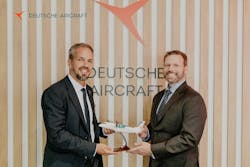Deutsche Aircraft selects Crane Aerospace & Electronics to supply proximity sensing system for D328eco
WESSLING, Germany - Deutsche Aircraft in Oberpfaffenhofen, Germany needed proximity sensing systems for its D328eco, a 40-seat regional turboprop aircraft. They found their solution from Crane Aerospace & Electronics, a division of Crane Company in West Caldwell, N.J. This decision follows Crane's earlier selection to provide the brake control system for the same model.
Crane Aerospace & Electronics has a long history of supplying proximity sensing components and systems to aircraft manufacturers, specializing in high-reliability position sensing for aircraft mechanical systems. The company has previously provided similar systems for Deutsche Aircraft’s earlier D328 turboprop and will now integrate its latest proximity sensing technology into the D328eco.
“We are pleased to be working with Deutsche Aircraft and look forward to supplying the D328eco with our latest proximity sensing solution,” said Joseph Mundinger, Vice President and General Manager of Sensing & Power Systems at Crane Aerospace & Electronics. “Customer satisfaction is our top priority, and we are committed to providing the D328eco with a premier system that will benefit Deutsche Aircraft’s customers.”
Nico Neumann, Chief Operating Officer at Deutsche Aircraft, commented, "We are glad to continue our ongoing partnership with Crane Aerospace & Electronics, a highly esteemed organization in our industry. Their proven expertise will be crucial for Deutsche Aircraft’s efforts to advance the completion of our D328eco."
The D328eco is driven by two Pratt & Whitney PW127XT-S turboprop engines, delivering notable improvements in fuel efficiency, reduced emissions, and enhanced thrust-to-weight ratios compared to earlier models. These engines are also designed to accommodate sustainable aviation fuel (SAF), bolstering the aircraft’s environmentally friendly attributes. With a cruising speed of approximately 620 km/h (335 knots) and an operational range of around 2,000 kilometers (1,080 nautical miles), the D328eco is well-suited for regional routes.
The cockpit features a modern glass avionics suite that enhances situational awareness, automates key functions to lighten pilot workload, and integrates the latest navigation and communication technologies. Designed to meet stringent safety and ergonomic standards, the cockpit prioritizes pilot comfort and operational efficiency. The aircraft is also equipped with a digital fly-by-wire system that improves control accuracy, stability, and safety while supporting advanced autopilot capabilities.
